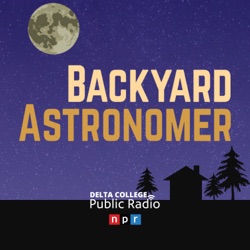Episoder
-
If you follow the arc to Arcturus and keep the curve going even farther down into the south, you’ll come to the faint bluish star, Spica.
-
Now that we’re past full moon, the early evening sky remains dark for longer periods as the moon rises later each night. This reveals a really nice target for binoculars called the Coma star cluster.
-
Manglende episoder?
-
In spring, many stargazers use the zodiacal constellation of Leo the Lion as a signpost to the sky.
-
All this week, the phase of the moon grows larger and brighter as it moves from first quarter toward full. We call this period the “waxing gibbous moon” as the oval shape becomes wider and more rounded.
-
Twice each year the Earth crosses the orbit of Halley’s Comet. Each time we do, a meteor shower is created from the tiny flecks of ice and dust the comet leaves behind in its orbit.
-
During mid-spring, a trio of wide-spread stars covers a huge swath of the eastern sky after dark. It’s the Spring Triangle signaling the move into longer days and warmer weather for the Northern Hemisphere.
-
Each season has that one constellation that serves as a signpost to the sky. In spring, many stargazers use the constellation of Leo the Lion.
-
Spring is the time of year when the Big Dipper climbs higher into the northern sky, but the Big Dipper is not itself a constellation. It’s only part of a much larger group called Ursa Major, the Great Bear. It also makes for a great guidepost to other stars and constellations!
-
During the week of March 31, the waxing crescent Moon makes its appearance in the west after sunset. When the moon looks like a thin crescent, there's a feature to look for called earthshine.
-
With the moon out of the way, the early evening sky remains dark and full of stars, and that gives us some fine objects to explore with binoculars.
-
This year, the March equinox arrives on the 20th which marks the first day of spring for the northern hemisphere.
-
This month, the full moon on March 14 is also known as the "Sap Moon" because March marks the tapping of the maple trees. It also coincides with a total lunar eclipse.
-
Over the last few months, we’ve been treated to the brilliant planet Venus piercing the western sky after sunset. During the first part of March, you’ll have a rare opportunity to watch the elusive planet Mercury join the show!
-
Sirius, Procyon, and Betelgeuse form a giant triangle in the southern sky known as the Winter Triangle. And like Orion’s Belt, it can make for an excellent pointer and guidepost to the winter night sky.
-
As the moon wanes and rises later each night, the early evening skies are dark again, allowing us to see the Great Orion Nebula.
-
From now through mid-March, you’ll have an opportunity to see the crescent phase of Venus when viewed through a telescope.
-
At the beginning of the week of February 3, the moon shows a crescent shape in the southwest after sunset. But each night, the moon will appear to slip a little further back or eastward among the stars, allowing more of the sunlight side to face the earth.
-
The parade of four planets visible across the sky will soon reduce to three as Saturn drops lower in the west each night, fading into the glare of twilight by the end of February.
-
About two hours after sunset, look high in the east for the brilliant planet Jupiter. A little to the lower right of Jupiter is the orange star Aldebaran, the fiery eye of Taurus the Bull.
-
During the week of January 13, a magnificent parade of planets will arch across the early evening sky. It's also when Mars comes closest to Earth and will be at its brightest.
- Vis mere


